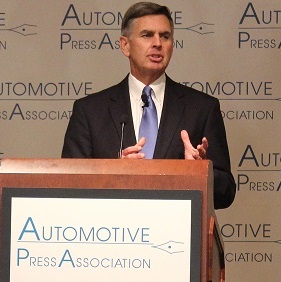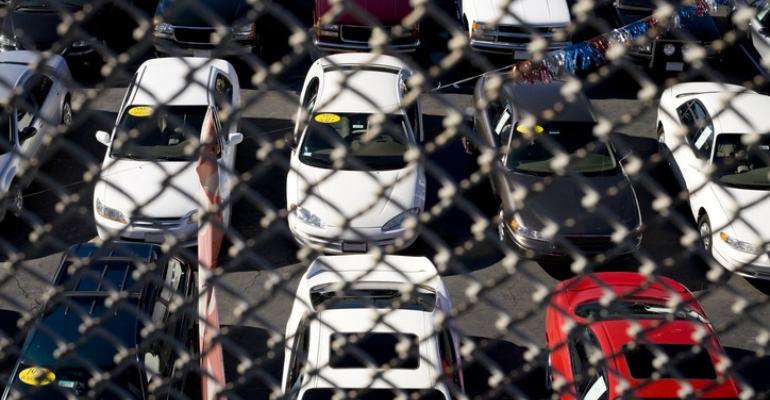Product affordability has become a big auto industry issue, but what’s causing the steady rise in new-car transaction prices?
Part of it is that automakers are putting more advanced technology systems into their vehicles, making some of them semi-autonomous in their ability to do things such as automatically brake and maintain lanes to avoid collisions.
“We need to make sure new vehicles, especially with all the new technology and safety features that are being added to them, remain affordable for all of our customers,” Charlie Gilchrist, 2019 chairman of the National Automobile Dealers Assn., tells Wards in an interview. “The affordability issue really permeates everything we do.”
The average lease payment now stands at $494 a month and the average monthly loan at $566, says Charlie Chesbrough, Cox Automotive’s senior economist. The prospects of paying that 12 times a year sends many budget-minded consumers to the used-car lot.
 “Affordability is a big issue,” he says.
“Affordability is a big issue,” he says.
But in addition to more expensive, technology-laden products, another element to rising vehicle transaction prices – averaging $37,590 in September, according to Kelley Blue Book – is that many consumers opt to pay more. (Chesbrough, left)
They are buying more vehicle. They are purchasing SUVs and CUVs that are more expensive than cars. They are buying tricked-out pickup trucks. For example, the base price for a Jeep Gladiator is about $45,000, but a typical transaction price with assorted options and accruements is about $60,000. For a midsize truck.
Despite the affordability concerns, isn’t the fact that customers on their own readily pay more for vehicles a sign of a strong economy?
Yes, Chesbrough tells Wards. But he adds a proviso: “When times are good, the buying of more vehicle is a good sign. But that guy buying the big SUV or the big truck could disappear when times get tough. Those are the first to go.”
The U.S. saw that disappearing act in the last recession a decade ago: People bought far fewer new vehicles (10.6 million vs. 17.2 million last year) and many automotive consumers who bought anything at all went for cheaper used vehicles.
Even though there’s vague talk of a new recession possibly rearing its head at some point, the rocking U.S. economy has seen 10 straight years of growth.
“We hear of a recession, but we haven’t seen much evidence of it in the vehicle market,” Chesbrough says.
Positive economic signs include a “phenomenal labor market” with unemployment of 3.5%, the lowest it has been since 1969, he says, also citing credit availability as another “green light.”
The auto industry between 2016-18 sold 51.7 million vehicles, a record run, according to Wards Intelligence. But pent-up demand isn’t infinite. “How many more people are out there that need a new vehicle?” asks Chesbrough.
Cox predicts new-vehicle sales will decrease to 16.8 million this year. Wards Intelligence more optimistically forecasts 17 million. But circumstances, unforeseen or looming, could come into play.
A big one is the Trump Admin.’s threatened 25% tariff on European auto imports.
If carried out, that “would be a huge issue for us,” Gilchrist tells auto journalists Oct. 8 in Detroit.
 If such a tariff were slapped on imports, the NADA chairman predicts fewer U.S. auto sales, higher vehicle prices and massive job losses, including an estimated 117,000 at dealerships. (Gilchrist in Detroit, left)
If such a tariff were slapped on imports, the NADA chairman predicts fewer U.S. auto sales, higher vehicle prices and massive job losses, including an estimated 117,000 at dealerships. (Gilchrist in Detroit, left)
Meanwhile, although used-vehicle prices have softened lately, that market remains robust, with Cox predicting 39 million pre-owned vehicle sales this year. The difference between a monthly new-car lease and used-car loan payment is $75, “making used cars more attractive,” Chesbrough says.
He predicts 4.1 million off-lease vehicles will enter the used-car market this year and a similar number next year, creating “considerable competition to new-vehicle products.”
An irony is that automakers themselves own and, through their dealers, remarket those off-lease vehicles. “Automakers not only have to worry about their competitors, but also competition from their own vehicles built three years ago,” Chesbrough says.
Those “gently used” low-mileage off-lease vehicles typically are reconditioned when necessary, certified and warrantied.
They sell at 30% to 40% less than new products. That tempts many buyers, including those on a budget and those who aren’t but still bargain-hunt. “There’s a desire for value out there,” Chesbrough says.
Pre-owned premium vehicles outperform other segments, he notes. “People get a good price on a used luxury vehicle, and still drive around with a big label on their car.”





